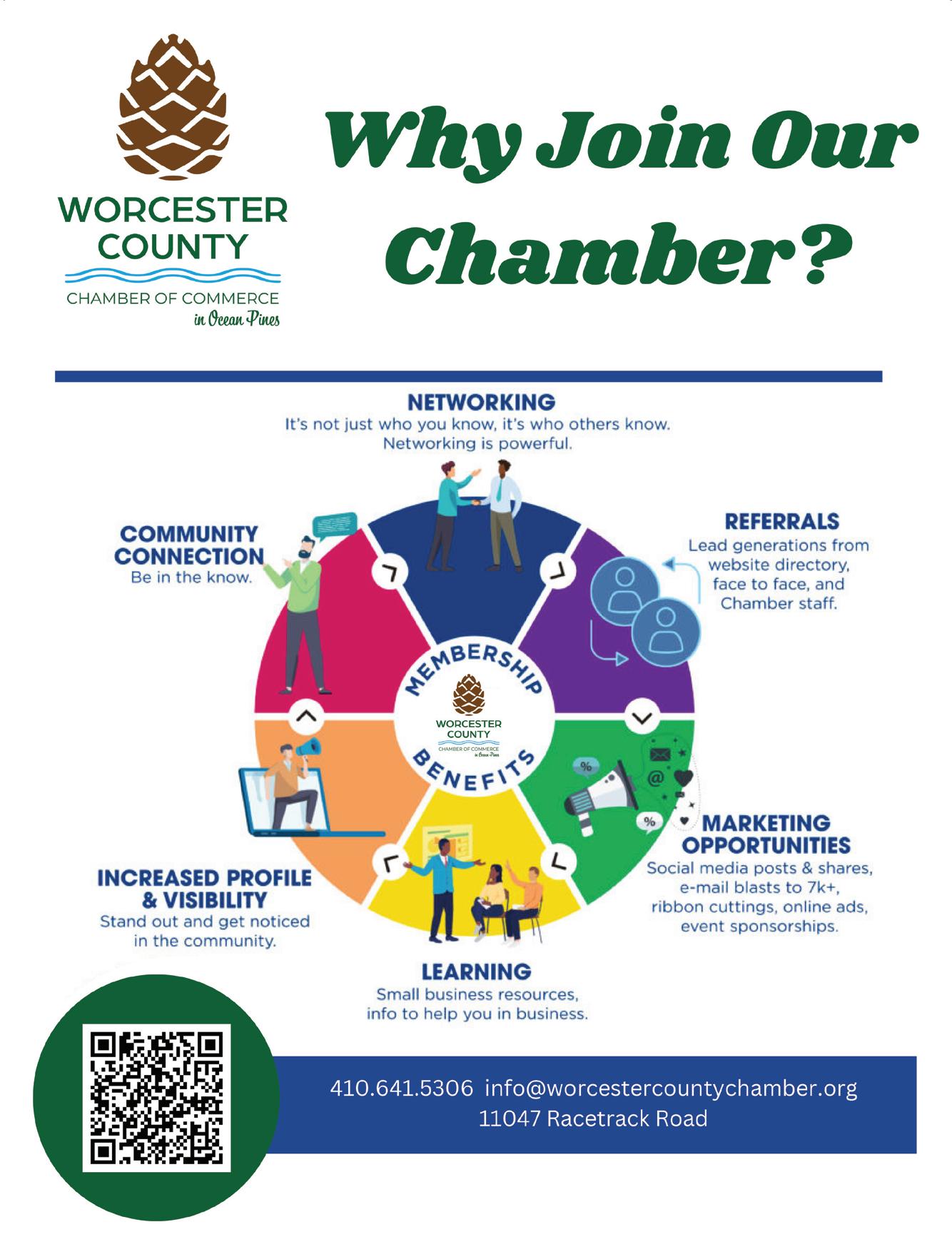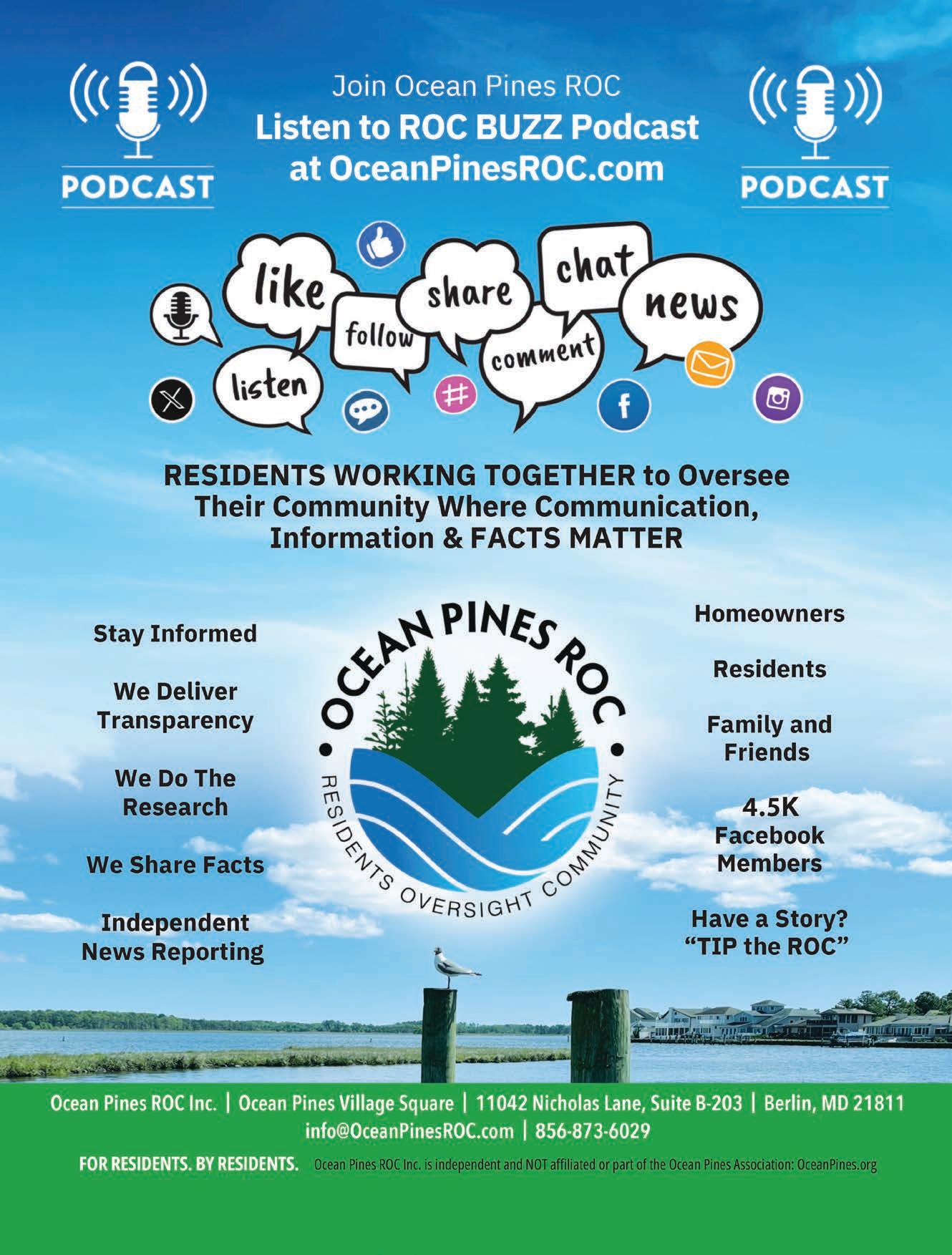October
R C Edition
Ocean Pines board eliminates committees amid fierce resident backlash
By Sherrie Clifford ROC Edition Publisher
The Ocean Pines Association Board of Directors voted Sept. 20 to eliminate nearly all of the community’s advisory committees, a move that drew sharp criticism from residents and raised alarms about transparency, oversight and the future of homeowner involvement.
The Saturday morning board meeting began like any other but quickly turned into a rare show of emotion and dissent. The meeting room, normally half-full, was packed to capacity. Extra chairs were brought in and still it was standing room only. By the time public comments opened, 14 residents were lined up to speak, most expressing anger and disbelief that their years of volunteer service had been ended with little more than an email.
The agenda included a motion by Director Jeff Heavner to terminate standing committees, followed by a first reading to repeal the resolutions that created them. For many, the abruptness of the action and the lack of prior notice, discussion or respect for volunteers was as troubling as the outcome itself. Of particular concern was the elimination of the By-laws and Resolutions Committee, which has long overseen updates to governing documents.
Keith Kaiser of Ocean Pines, a six-year member of the By-laws Committee, warned that eliminating committees would undo decades of
best practices. He stressed that while both board and committee members are volunteers, only directors receive free amenities, while committee members work without compensation. To throw away the committee system, he argued, was to discard the institutional knowledge built through years of experience and legal precedent, leaving future boards to “make it up as you go along.”
Gary Miller of Ocean Pines, chair of the Aquatics Committee and a member of the Strategic Planning Committee, said the move ignored years of contributions that made Ocean Pines stronger. Miller pointed to successful initiatives like the community kickoff event that grew directly out of
See ELIMINATES page 2
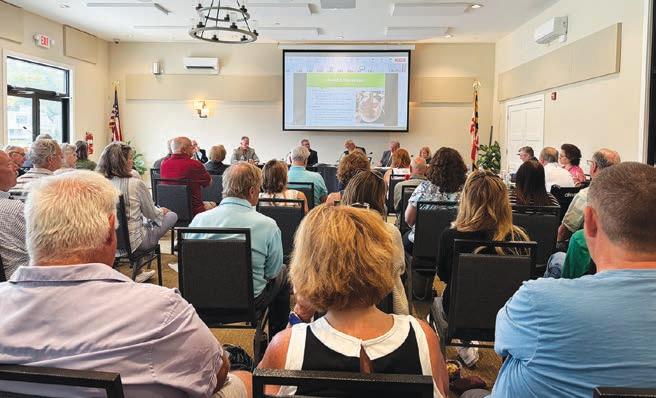
Ocean Pines Association Board of Directors sparks strong community opposition by voting to terminate most advisory committees, prompting concerns over diminshed transparency and resident participation.
Ocean Pines to relocate helicopter pad for safer medevac operations
By Sherrie Clifford ROC Edition Publisher
Ocean Pines officials are preparing to move and enlarge the community’s helicopter landing pad, a step aimed at improving safety for modern medevac aircraft that are larger and heavier than those in use when the pad was first built.
The current pad, located at the South Side Fire Station, has a
diameter of about 25 feet. Fire officials said that while helicopters are still able to use the site, the limited space has at times required pilots to reposition or attempt a second landing when the skids did not line up evenly. That margin of error has raised concerns as Maryland State Police and other agencies now fly helicopters capable of carrying a four-person crew, a patient and often an additional provider.
At the Ocean Pines Association Board of Directors meeting on Sept. 20, General Manager John Viola outlined plans to shift the pad roughly 20 yards from its current location and build a wider replacement. The cost is projected at $10,000 to $15,000 and the Ocean Pines Volunteer Fire Department will pursue grant funding to offset expenses.
See HELICOPTER page 3



ELIMINATES
Continued from page 1
committee discussions. He argued that replacing standing committees with temporary task forces would silence the resident-driven insight that shaped many improvements and instead centralize power in management and the board.
Donna McElroy of Ocean Pines, a 25-year homeowner and longtime Marine Activities Committee member, pushed back directly against Heavner’s claim that committees were no longer needed. She listed accomplishments ranging from the oyster restoration project, which now involves 100 residents, to canal water testing and safety outreach with the Anglers Club. McElroy asked pointedly who would now present results and care for these initiatives, warning that eliminating committees would strand unfinished projects and erode momentum.
Lora Pangratz of Ocean Pines, chair of the By-laws and Resolutions Committee, delivered a blunt assessment. Without her committee, she said, oversight of governing documents would fall to attorneys or staff, driving up costs and undermining transparency. Pangratz reminded the board that her group operated under Robert’s Rules, kept detailed records and provided continuity as board members cycled in and out. Standing committees, she argued, are “a blessing, not a hindrance,” and she urged the board to restructure if needed, but not to dismantle the system entirely.
Bill Hayes of Ocean Pines, said eliminating committees would erase the institutional knowledge that helps new directors understand past decisions. He questioned why committees were being cut at the same time the board approved $325,000 in spending for clubs without advance notice on the agenda or committee review. Hayes invoked the legacy of Joe Reynolds and other community leaders who built Ocean Pines’ volunteer framework, warning that their voices and the lessons they left behind would disappear along with the committees.
Cheryl Jacobs of Ocean Pines, a property owner since 2001 and former vice president of the board, said she was “godsmacked” by the decision. Committees, she reminded directors, are part of Ocean Pines’ history and success. If individual members caused problems, she argued, the solution was to fix those issues, not destroy the entire structure. Jacobs called for a town hall to allow broader input before any final decision, urging the board to reconsider what she called a drastic and misguided move.
Throughout the meeting, the board sat mostly silent as one resident after another condemned the decision. Their silence left many to wonder if the directors, seven of whom are assigned as liaisons to the very committees they just voted to eliminate, have reduced their role to little more than attending one meeting a month. Critics noted that directors continue to receive free amenities, raising the question of whether board service is truly “volunteer” work when it comes with perks. Meanwhile, committee members, who received nothing in return, gave hundreds of hours to research, oversight and projects now left unfinished.
The larger fear expressed during public comments was that this could be just the first step in concentrating authority. Residents worried aloud that a board willing to erase longstanding committees without discussion might soon take even greater control, with fewer checks from volunteers or homeowners. Out of more than 8,500 households in Ocean Pines, only a small fraction attended the meeting or spoke out—a warning, some said, that apathy could allow decisions like this to go unchecked until it is too late.
Several directors campaigned in past elections on the importance of committees, yet are now eliminating them. Residents asked what changed: Was it too much work to listen to committees or was it simply a way to quiet homeowners who brought forward inconvenient questions?
For many in the standing-roomonly crowd, the board’s short-sightedness was the most painful part. The committees were not perfect, but they represented the community’s voice. By removing them, the board not only dismissed volunteers but also signaled that decisions affecting Ocean Pines’ future may now rest solely in the hands of a few.
The outcome left residents with a clear choice: either pay attention and hold leadership accountable or risk a future where homeowner voices are sidelined permanently.
As Pete Keizer warned, “If you think this ends with the committees, you haven’t been paying attention.”
Terminated committees: Aquatics, Golf, Recreation and Parks, Environmental and Natural Assets, Strategic Planning, By-Laws and Resolutions, Communications. The Board had previously eliminated the Racquet Sports Committee and the Clubs Committee.
Remaining committees: Budget and Finance, Architectural Review, Elections and the Search Committee.
Ocean Pines prepares to advance cell tower project amid ongoing service gaps
By Sherrie Clifford ROC Edition Publisher
Plans for a new cell tower in Ocean Pines are moving closer to reality, with community leaders signaling readiness to address years of dropped calls and poor reception that have frustrated residents and raised safety concerns.
Police Chief Tim Robinson, who is coordinating the project, said he intends to notify Milestone Towers that the Ocean Pines Association is prepared to move ahead. The company has been working with Verizon, T-Mobile and AT&T on design and placement.
For more than a decade, homeowners have reported dead zones and unreliable service. The problem has become especially acute during summer weekends and holiday events, when network use spikes and even emergency calls have been dropped. ROC Edition first reported in July that a 143-foot tower was being considered behind the golf course maintenance building, a central location deemed the most viable after a review of other sites.
At the latest board meeting, Verizon officials explained how the structure is expected to improve service throughout most of Ocean Pines. Earlier planning maps showed a one-mile zone of strongest reception, but carriers clarified that those documents were technical and not
HELICOPTER
Continued from page 1
Fire President Joe Enste said the new design will provide about 40 by 40 feet of landing space—not the 100-square-foot area sometimes recommended in county guidelines, but enough to give crews greater confidence and reduce the chance of overshooting the edge. “This will be a big improvement over what we have now,” he said.
The project is part of a broader conversation about medevac access across Worcester County. FAA guidance calls for emergency-use pads to be at least 40 by 40 feet, with surrounding clear zones to accommodate larger rotor diameters. Worcester County’s emergency management team is also reviewing options to add Instrument Flight Rules (IFR) sites that would allow
meant to represent the full area of impact.
Engineers are also studying whether to extend the tower height to 175 feet to further strengthen coverage. Anything taller could cause interference with other towers in the region, so the option is being reviewed with caution.
Directors questioned whether temporary measures could help until the tower is built, a process estimated to take at least 18 months because of permitting and supply chain delays. Carriers responded that the existing network is in such poor condition that minor upgrades would not bring meaningful relief. Portable cellular stations on trucks, known as COWs, may be available for short-term use at events like the Fourth of July but are not a permanent solution.
Board members again emphasized that reliable service is not just a matter of convenience but of safety. Concerns over delayed responses to 911 calls have been raised repeatedly at public meetings.
Robinson said the next step is to work with Milestone Towers, but the project must still clear both county and state approvals. Delegate Wayne Hartman is assisting in moving those applications forward. However, the board has not yet held a formal vote but expressed broad support and said they do not want the project delayed any further.
pilots to land using onboard instruments rather than depending solely on visibility.
Ocean City recently installed such a system at Northside Park. County leaders are now studying whether similar installations could be added at locations in the north, central and southern ends of Worcester, including Ocean Pines. IFR technology is considered valuable during storms, heavy fog or high winds, when helicopter pilots may otherwise have to divert.
There is no confirmed schedule for the relocation, but Viola said the community intends to begin in the near future. The upgrade will allow faster, more reliable medevac access for emergencies ranging from trauma cases to critical patient transfers.
Officials stressed that while the existing pad has served Ocean Pines


Ocean Pines pushes forward with a new cell tower to resolve connectivity issues and safety concerns.

and
better suit modern medevac
response efficiency.
for years, it no longer meets the realities of today’s rescue aircraft. The planned move is expected to provide a safer, more reliable landing
area and ensure the community is prepared for the next generation of emergency aviation needs.
Shore Regional Eye expands to Berlin with a new outpatient surgery center
By ROC Edition Staff
Newly open in Berlin, Shore Regional Eye, which first launched its local ophthalmology office in June 2025, expanded in August with the debut of a dedicated outpatient surgery center. The facility brings advanced eye surgeries closer to Eastern Shore residents and highlights local ophthalmologist Dr. Raymond Clifford, who owns and leads the practice with deep regional ties.
Located at 9956 N. Main St., Suite 4, the center is equipped for cataract removal, glaucoma treatments, eyelid surgery and other ophthalmic procedures. Administrators said the new addition reflects Shore Regional Eye’s mission to provide comprehensive care under one roof, from consultation to surgery to follow-up.
The center features high-definition imaging and precision surgical tools that allow delicate procedures to be performed more efficiently and with faster recovery times. Cataract surgery, one of the most common procedures, is now performed locally on an outpatient basis. Minimally invasive glaucoma surgery, eyelid corrections and laser treatments are also part of the offerings.
Dr. Clifford, who has practiced on the Eastern Shore since 2016, approaches eye disease with what he describes as a systemic view. He emphasizes active patient participation through education, diet and exercise in addition to medical and surgical treatment. “Eye health cannot be separated from overall health,” he often notes, underscoring his philosophy that preventive care and patient involvement are as critical as advanced technology.
Beyond surgery, Shore Regional Eye provides a wide range of diagnostic, medical and in-office treatments. The practice uses cutting-edge diagnostic imaging, such as slit lamp photography, fluorescein angiography and OCT-Angiography, which allows for non-invasive blood vessel mapping. These tools help detect and manage conditions including macular degeneration, glaucoma and diabetic eye disease often before patients experience vision loss.
Insurance-covered, in-office laser procedures are available for postcataract lens polishing, glaucoma treatment to lower eye pressure without additional drops and preventive measures for narrowangle glaucoma. In-office medical

care also includes eye injections for macular degeneration and diabetes, removal of eyelid lesions and cysts, biopsies of skin changes and drainage of styes.
The practice offers a full range of ophthalmic surgeries: cataract operations, minimally invasive glaucoma surgery, pterygium (“surfer’s eye”) removal and eyelid procedures to correct drooping lids or sagging lower lids. Retinal imaging systems at the center provide early detection of diabetic retinopathy and new-generation visual field testing equipment delivers faster, more comfortable glaucoma monitoring.
Care extends to all ages, with pediatric eye exams provided in a family-friendly environment. The practice also supports patients with dry eye, offering everything from dietary advice and medication reviews to prescription drops and office-based procedures. Emergency eye care services are available as well, with a commitment to see patients promptly when unexpected problems arise.
For patients, the immediate benefits of the Berlin surgery center are convenience and continuity. Consultations, pre-op assessments, surgery and post-op visits are all handled within the same network, reducing travel and eliminating the stress of coordinating among multiple providers.
The practice noted that demand for eye care will continue to grow as the Eastern Shore’s population ages. With its new surgery center and a full suite of diagnostic and treatment services, Shore Regional Eye is positioned to meet that demand while ensuring residents have access to high-quality, comprehensive care close to home.
Appointments for surgical consultations and general eye care are now available. For more information, contact Shore Regional Eye at 443-242-4070 or visit www.shoreregionaleye.com.
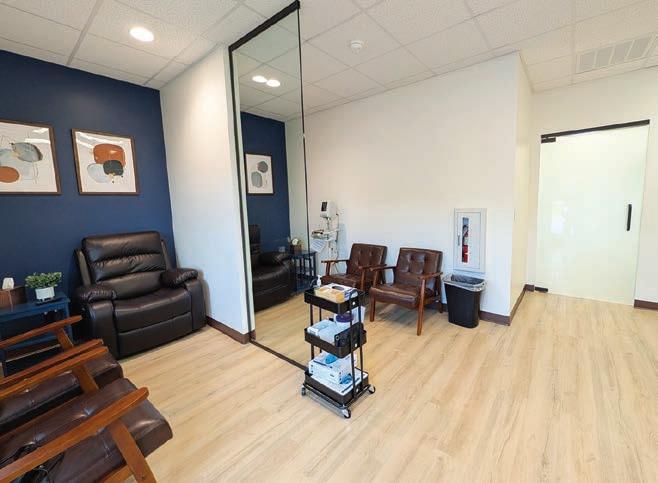


Ocean Pines board reviews Deeley Insurance renewal package for 2025-2026
By Sherrie Clifford ROC Edition Publisher
With the Ocean Pines Association’s (OPA) insurance portfolio soon coming up for renewal, board members received a detailed update from Deeley Insurance during their Sept. 20 meeting. The presentation, delivered by Megan Muller, CIC, outlined the community’s wideranging coverage and confirmed a modest increase in the overall cost.
Muller said the total premium will rise from $639,220 for the 2024–2025 policy year to nearly $667,000 in 2025–2026. She noted the change reflects market trends and adjustments across multiple lines of coverage but added that Ocean Pines continues to carry extensive protections relative to its size and risk profile.
The September 2025 Ocean Pines Association Insurance Overview covered every major policy carried by the association. Property insurance through Philadelphia Insurance and Lloyd’s of London insures
$29.3 million in values, with a $10,000 deductible for all perils and a separate $10,000 deductible for wind. Flood coverage through Selective and Lloyd’s provides $12.5 million in insured values with deductibles ranging from $1,250 to $2,000.
Crime coverage includes $3 million for employee theft, $3 million for forgery and alteration and $25,000 each for money and securities inside and outside facilities. The deductible is $1,000. General liability protection provides $2 million per occurrence for bodily injury and property damage, $4 million for products and completed operations, $4 million for personal and advertising injury and $1 million for liquor liability.
OPA’s auto coverage carries a $1 million combined single limit for bodily injury and property damage, $500,000 for uninsured motorists, $2,500 in personal injury protection and additional protection for non-owned and hired vehicles.
Directors and Officers coverage through CNA provides $2 million per occurrence and $2 million in defense costs, with a $25,000 deductible. Cyber liability, carried with BCS and Scottsdale, offers $5 million for first-party claims and $5 million for third-party claims, with a $5,000 deductible.
OPA also maintains specialized coverage for its facilities and operations. Marina operators legal
liability through Travelers includes $1 million per occurrence, while inland marine coverage insures $2.68 million in scheduled equipment, $100,000 in unscheduled tools and more than $2 million in combined hardware and software coverage. Storage tank pollution liability with Crum & Forster Specialty provides $1 million per occurrence, aggregate and defense costs.
Because OPA operates camp programs, liability coverage with Accelerant Specialty includes $1 million per occurrence, $3 million aggregate, $2 million aggregate for sexual abuse and molestation and $5 million in excess liability. Sports camp accident coverage provides $25,000 per occurrence. Police professional liability with Indian Harbor covers $3 million for each wrongful act, with a $10,000 deductible.
Workers compensation through Chesapeake Employers Insurance includes $500,000 per accident, per disease policy limit and per employee for disease coverage. To extend protections, OPA also carries umbrella liability with Philadelphia and QBE, raising coverage limits to $20 million per occurrence and aggregate, with a $10,000 retention.
Muller told the board the portfolio is designed to balance affordability with broad protections. High coverage levels shield the community from catastrophic losses, while deductibles help keep premiums manageable by leaving smaller claims as the association’s responsibility.
Board members acknowledged the scope of the coverage and said it reflects the responsibilities of the association, which manages facilities such as the Yacht Club, Beach Club, marinas, police operations and recreational camps. Leaders said comprehensive insurance is critical to ensuring both financial stability and public safety.
The renewal process will be finalized this fall, with the new policy year taking effect shortly afterward. Deeley Insurance will continue working with OPA staff to confirm terms and maintain protections as risks evolve.
For more information, residents can contact Megan Muller, CIC, Deeley Insurance, at mmuller@deeleyinsurance.com or by call or text at 410-213-5578.

Megan Muller of Deeley Insurance presents the 2025-2026 insurance renewal package to the Ocean Pines board on Sept. 20, detailing a premium increase to approximately $667,000 and a diverse set of policies covering property, liability and specialized protections for the community’s assets and programs.

Now Open and Accepting New Patients






Ocean Pines budget stays positive with $274,578 surplus year-to-date
By Sherrie Clifford ROC Edition Publisher
The Ocean Pines Association closed August with another month of favorable financial results, finishing $106,805 ahead of budget for the operating fund. Year-to-date, the community stands $274,578 favorable, continuing a steady pattern of positive performance that has carried through most of 2025.
ROC Ledger ROC Tribute
The August results were fueled by revenues that came in $92,987 over budget, combined with expenses that were $13,817 under projections. Since the beginning of the fiscal year, revenues are $209,806 ahead of plan, while expenses are $64,772 under budget. Favorable variances provide the association with flexibility to reinvest in the community rather than representing a simple cash surplus.
Golf operations once again played a key role in the favorable outcome. The department generated $78,582 in net revenue for August, which was $33,056 ahead of budget. Year-to-date, golf remains $26,698 favorable. Strong seasonal participation and steady member play contributed to the gain, supported by reinvestments in irrigation upgrades, new turf and fairway maintenance.
Marinas also finished the month on a strong note, posting a $13,654 favorable variance. Year-to-date, marinas are $39,618 ahead of budget, supported by high slip rental demand during the peak boating season. Beach parking, a major summer revenue generator, ended August $3,929 under budget and stands at a negative $15,023 variance year-to-date. Even so, revenues remain strong at more than $500,000 for the year.
Aquatics came in $1,535 under budget for August. The program has generated $307,892 year-to-date, essentially flat to budget projections. Recreation and Parks reported a net revenue of negative $80,633 year-todate, a $59,335 favorable variance compared to budgeted losses.
Food and Beverage continues to show mixed results. August closed $9,912 under budget and yearto-date revenues stand at $224,356, which is below last year’s yearto-date revenue of $646,955. Still, the transition to Touch of Italy management has stabilized operations and planned facility upgrades at the Beach Club, Yacht Club and Clubhouse are expected to strengthen future performance. Not all departments finished the month on a positive note. Public Works ended August $4,975 under budget and remains $8,054 unfavorable year-to-date, reflecting higher maintenance and repair costs. General Maintenance produced a $2,316 favorable result for August but remains $14,667 under budget year-to-date, tied to infrastructure upkeep and seasonal workload pressures.
Racquet Sports posted a $2,892 favorable variance in August but remains $38,832 unfavorable year-to-date since pricing structure changes were introduced earlier in 2025. The program will be monitored for at least a year before conclusions are drawn.
Public safety expenses remain one of the largest categories. Police reported a favorable variance of $11,103 for August and stand $18,870 ahead of budget year-todate. Fire/EMS was essentially on budget, with no variance reported for August.
Compliance, Permits and Inspections contributed positively with an $8,084 favorable result for August, bringing the year-to-date variance to $13,238 ahead of budget. General Administration also remained a strength, closing with a $134,562 favorable variance year-to-date.
Overall, the operating fund remains $274,578 ahead of budget, though results are lower compared to last year. The surplus provides flexibility as the board weighs capital initiatives, including the Beach Club renovations, Yacht Club kitchen project and golf irrigation improvements.
For homeowners, the August results serve as reassurance that Ocean Pines remains financially stable. Strong amenity revenues, cost controls and ongoing planning suggest the association is on track to finish 2025 in positive territory while preparing for the next phase of community investment.
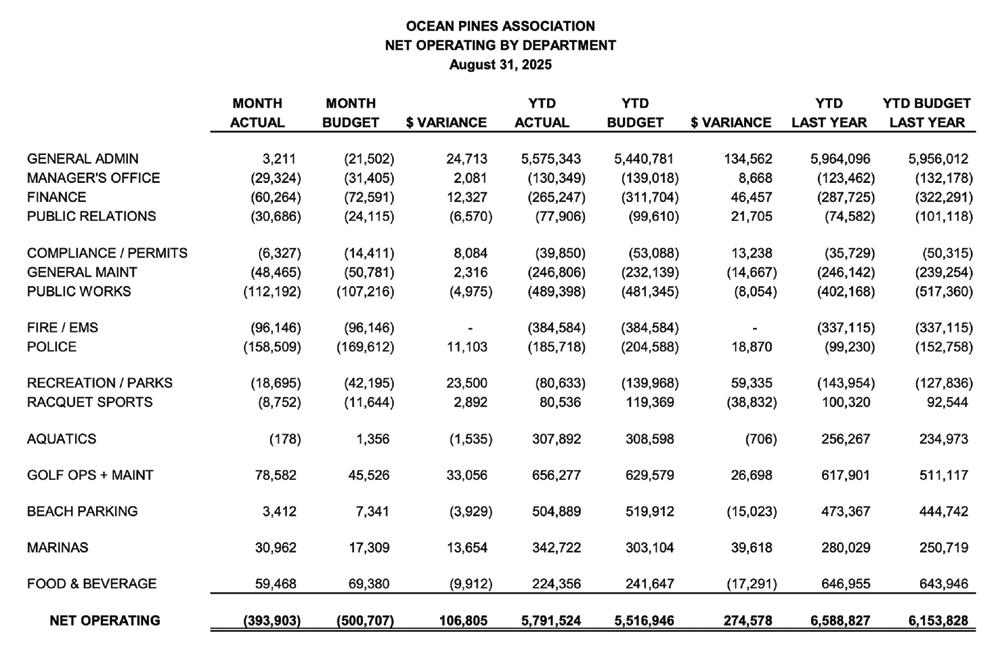
Capital requests approved without any indication on the agenda; board procedure questioned
By Sherrie Clifford ROC Edition Publisher
The Ocean Pines Association (OPA) Board of Directors approved funding for three capital projects at its Sept. 20 meeting even though no capital requests were listed on the published agenda. Only after the votes were taken did the board amend the agenda to reflect the approvals, raising questions about why proper procedures were not followed.
General Manager John Viola emphasized during his presentation that his requests were limited to moving forward with architectural and engineering plans. He said he was not seeking approval for construction spending.
The first request, estimated between $75,000 and $100,000, was for architectural drawings and engineering work at the Beach Club. Viola explained the goal was to prepare detailed plans for suggested renovations, including installation of an elevator, construction of a second-floor deck and replacement of existing doors with accordionstyle doors to improve access and ventilation. The request also covered basement improvements, where a dehumidifier was needed to address moisture issues. While the initial step was to fund planning, officials acknowledged that the elevator itself could ultimately carry a price tag of about $225,000 once construction is considered. After a brief discussion confirming the basement work was included, the motion passed 6-0, with Treasurer Monica Rakowski absent.
Viola next sought approval for a shade structure at the Golf Clubhouse. He estimated this request to cost between $75,000 and $100,000, hoping to complete the work over the winter. President John Latham moved for approval, seconded by Director Stuart Lakernick. Director Steve Jacobs objected, saying the board should first receive details from Touch of Italy, OPA’s food and beverage vendor. The motion carried 5-1, with Jacobs opposed as he would like to see more details. Lakernick described the step as aggressive but necessary, while Latham said it could create new revenue opportunities. Viola noted that Touch of Italy plans to add a pizza oven beneath the shade structure at its own cost once the pavilion is in place.
Viola then introduced a third proposal: construction of a structure



at the Yacht Club to house an outdoor kitchen for Touch of Italy. He said the addition would relieve stress on the existing kitchen and could be finished by next summer. Viola estimated this cost to OPA at $125,000. Latham moved for approval, seconded by Lakernick. Jacobs asked about location and Viola explained the kitchen would be a 20-by-20-foot structure near the bocce courts that would not reduce patio space. The motion passed 6-0. Touch of Italy would be responsible for outfitting the kitchen with equipment, while OPA would cover the cost of the structure itself.
By the end of the meeting, the board had approved all three measures despite none appearing on the published agenda. To correct the record, OPA’s attorney Bruce Bright advised the board to amend the agenda so the votes could be logged as capital requests. Bright cautioned, however, that the approvals should not be mistaken as authorization to
build. Parliamentarian Doug Parks agreed and the motion to amend the agenda passed 6-0.
The sequence of events created confusion for some homeowners. Capital projects are typically listed on the published agenda so residents can follow deliberations and weigh in before votes are taken. Standard procedure also involves multiple steps: an initial vote to authorize planning, a later vote to approve expenditures once bids are received and final review of contracts. Because the Sept. 20 actions were logged as capital approvals and only added to the agenda afterward, many questioned what the board had actually authorized.
Viola later clarified that he had only sought permission to begin planning. “I did not seek approval for actual spend. That would be the next step after a process to obtain,” he said. He added that his understanding was the board’s intent was to approve the planning phase while
signaling interest in potentially funding construction later.
OPA officials said the Sept. 20 votes represent the beginning of a longer process to address improvements at the Beach Club, Yacht Club and Golf Clubhouse. Still, the procedural missteps left lingering questions. Experienced directors and staff are familiar with the capital request process and residents are now asking why three projects of significant cost advanced without first appearing on the agenda.
The controversy highlights broader concerns about transparency and process in Ocean Pines governance. Homeowners expect to be notified and given the opportunity to follow deliberations on spending decisions that affect major amenities. By approving funding before amending the agenda, the board gave the appearance of acting first and correcting later, a sequence that has fueled skepticism in the community.

Capital investments and strategic planning dominate Ocean Pines board updates
By Sherrie Clifford ROC Edition Publisher
Ocean Pines Association’s (OPA)
General Manager John Viola presented a wide-ranging update on capital projects, community amenities and long-term planning during the Sept. 20 Board of Directors meeting. The report touched on nearly every major initiative underway, from the volunteer fire department and Racquet Center upgrades to dredging and bulkhead replacement.
Viola said the work reflects both immediate needs and larger strategic goals, noting that 2025 will be a year of continued investment in public safety, infrastructure and quality-of-life improvements for homeowners.
OPVFD’S NEW SOUTH SIDE FIRE STATION
The update began with progress on the proposed south fire station project, a joint initiative with the Ocean Pines Volunteer Fire Department. Viola said the timeline now anticipates “shovel in the ground” by winter 2026, with several key steps already underway. He reported that OPA and the fire department met with the Technical Review Committee last week and that the Worcester County Planning Commission is scheduled to consider the project on Oct. 2. If approvals move forward, the next phase will be submitting construction permit applications. Additional tasks include confirming costs for plumbing and mechanical systems in mid-October and evaluating final proposals before bids are brought back to the board. Viola said the process is deliberate but necessary to ensure accuracy on costs and compliance with county requirements.
GOLF IRRIGATION AND MAINTENANCE
Viola also provided a detailed update on irrigation projects across the golf course, which have been divided into multiple phases. Phase I included upgrades to hole one, the fourth tee, hole nine, the practice range and the pump station at a cost of $934,000. An emergency phase, approved to address breaches in the system, covers holes two, three and 19 at a cost of $300,000. Phase II, the current phase, focuses on holes four through eight and is underway this fall at a cost of $900,000.
In addition to irrigation, maintenance work continues across the
course. New turf has been installed on the tee boxes at holes three and seven, greens and sand traps have been maintained and fairways are being aerified and seeded to improve playing conditions.
The irrigation and maintenance work are part of a broader effort to modernize the system, reduce water waste and improve playability. Viola said the remainder of the front nine is currently being addressed and a bulkhead replacement project scheduled for 2026 at the 18th green and fairway will also enhance the irrigation reservoir that serves the course.
RECREATION AND RACQUET SPORTS
Recreation programming remains strong, with high participation in youth camps and seasonal events. Viola said additional emphasis is being placed on expanding adult fitness offerings and creating more year-round opportunities. In the parks, new mulch was placed at both the dog park and playgrounds beginning in September, while pavers at the bocce courts are scheduled to be installed in October.
At the Racquet Center, crack repair and restripe covers 10 courts in total, including courts nine and 10 and the eight pickleball courts. The cost of the project is $57,875. Viola added that OPA has invested a total of $759,615 in the Racquet Center over the past six years, underscoring the community’s commitment to the facility as pickleball and tennis participation continues to grow.
DMA STUDY AND STRATEGIC PLAN
Viola said work continues on the DMA (Design Management Associates) study, which provides an independent review of OPA’s facilities and infrastructure needs. A contract has been signed at a total cost of $18,480 and DMA representatives will be on site Oct. 14-16 to conduct field work. A draft report is expected in mid-to-late December, ahead of the budget process. The study aims to produce updated budget estimates and inform the association’s strategic plan.
The general manager also updated the board on OPA’s broader five-year plan, originally released in 2022. He said initiatives outlined for 2022 through 2025 have largely been completed, with remaining projects to be addressed in the coming years. Departments are currently revising the plan for the


next five-year cycle. The updated plan is built on several fundamentals: enhancing the customer experience, investing in amenities, upgrading infrastructure, driving efficiencies, reallocating costs, generating organic revenue and providing excellent customer service. Viola said that once the revised plan is finalized, it will be uploaded to the OPA website for residents to review.
DREDGING AND BULKHEADS
Waterfront infrastructure also remains a priority, with dredging underway in several canals. Viola reported that Fisher Marine began work in early September after a more than three-year permitting process with the Maryland Department of the Environment and the U.S. Army Corps of Engineers. The current dredging list, first developed in 2021, includes canals on Clubhouse Drive, Dove Lane, Drawbridge Road, Driftwood Lane, Grand Port Road, Harborview Drive, Ivanhoe Court, Newport Drive, Ocean Parkway, Teal Circle, Watergreen Lane and White Sail Circle.
Bulkhead replacements are also moving forward. Viola said Fisher Marine is scheduled to begin the fiscal year 2025-2026 bulkhead
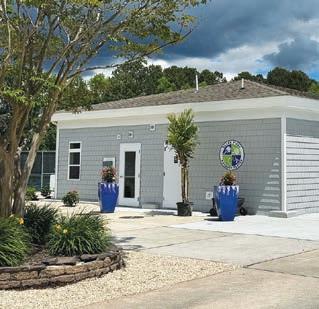
replacement project this month, covering odd-numbered homes from 49 through 91 Clubhouse Drive. The total cost is $675,000 and OPA is still awaiting price proposals for additional bulkhead work. Viola emphasized that dredging and bulkheads are both critical to maintaining property values and safe navigation in the waterfront community.
GOVERNING DOCUMENTS AND CPI
The general manager’s report also touched on policy matters. Viola said the governing documents workgroup is reviewing provisions to modernize and clarify OPA’s bylaws and regulations. Meanwhile, enforcement of CPI (Compliance, Permit and Inspection) regulations continues to be a focus, with staff working to balance consistency with homeowner outreach and education.
Ethics Matter: Why misrepresentation on the job always catches up EDITORIAL

In today’s job market, experience and fresh skills must go hand in hand. Employers look for both, but above all they expect honesty. A resume or profile that exaggerates accomplishments or lists a position no longer held may provide a temporary advantage, but deceit will always be discovered.
One of the clearest examples comes when someone claims a professional title without the ability to perform the work. It may look impressive on paper, but the truth will surface quickly once the job begins. When excuses pile up and frustration grows, what started as an opportunity can spiral into damaged relationships and a reputation that follows a person long after. The “bad apple” phase sets in and employers or colleagues begin to question everything that person has said about their background. Worse, this behavior can also harm coworkers, especially younger professionals who are misled or influenced in the wrong direction.
This is why accurate self-representation matters. If you no longer hold a role, don’t list it as current on your resume, Facebook page, or LinkedIn profile. When outdated or misleading information lingers online, it creates confusion for future employers and misleads peers in your field. Representing yourself as holding a position you left months or even years ago isn’t just careless; it undermines trust.
Employers want to see authenticity. A hiring manager would rather read about what you did accomplish than question whether you are inflating your experience. A resume or online profile should highlight measurable successes: training new staff, meeting deadlines, improving efficiency, or leading projects to completion. Those specifics carry far more weight than a title alone.
It is also important to remember that today’s hiring process moves fast. Recruiters use software that scans for key terms, but they also search social media to verify that profiles match the application. If your online presence tells a different story than your resume, red flags go up immediately Discrepancies suggest carelessness at best and dishonesty at worst.
The solution is straightforward. Keep your resume updated, refresh your LinkedIn regularly and remove outdated information from Facebook or other platforms where potential employers may look. Showcase continuing education or new certifications, but don’t list skills you cannot perform. Misrepresentation might get you through the door, but it won’t keep you there. Within months, the gap between claims and reality is exposed and the consequences are far more damaging than being honest from the start.
Ethics extend beyond resumes and into the workplace itself. Conflicts of interest such as taking on divided commitments with competitors rarely end well. Divided loyalties create distrust, damage reputations and can jeopardize entire teams or projects. Younger and more impressionable employees, including students just beginning their careers, are especially vulnerable when seasoned colleagues model unethical behavior. Instead of learning professionalism, they may adopt shortcuts and bad habits that ultimately limit their growth. Experienced workers have a responsibility to set the standard, not misuse their position or influence for personal gain.
Experience will always matter. But it must be paired with adaptability, current language and a commitment to ethics and honesty. Employers notice when someone takes pride in presenting themselves accurately and that credibility is often the difference between building a career and burning bridges.
The job market rewards integrity. No matter your age or background, the best path forward is to present yourself as you are with skills you truly bring, experience you can prove and principles that stand up under scrutiny. That is how you remain employable, respected and trusted.
Sherrie Clifford Publisher, ROC Edition
Follow the actions, not the slogans: Why charm without ethics destroys communities COMMENTARY
Where is your HOA community really headed and what lies beneath the surface? Too often, lofty promises hide a hidden agenda. That’s why it is critical to follow the actions, not the slogans and certainly not the personalities, parties, smooth talk or false promises. Communities falter when influence is seized not through service, but through secrecy, manipulation and egos. Narcissistic leaders thrive in such environments, preying on the weak, the lonely and those eager to feel important or accepted. What begins as an invitation to belong often becomes control, leaving disillusionment and division in its wake.
Slogans like “change,” “action,” or “involved” may sound inspiring, but too often they mask deeper motives. When the promises fade, what remains is disappointment, smooth words, arrogance and
control. That is why communities must ask hard questions: Who is really pulling the strings? Who are the partners operating out of sight? And is the silence intentional, a way to keep a darker history from being exposed?
One of the clearest signs of this kind of control is the elimination of advisory committees. Committees exist to provide perspective, transparency and the homeowners’ voice. Dismantling them does not create efficiency; it silences the very people who are, in truth, the shareholders of any association. The goal is not service, but consolidation. The result is not inclusion, but exclusion.
This is especially troubling when candidates campaign on the importance of volunteers, only to later dismantle the very committees they once claimed to value. That is not a shift in direction; it is betrayal.
Homeowners are left to wonder who they really voted for. When the charm wears off, the mask slips and the reality of control emerges, trust is already broken.
Manipulation in leadership is not abstract; it has consequences, and suspicion seeps into every corner of governance. Decisions, no matter how sound, are tainted by doubt.
The tactics are familiar: demoralizing others, diminishing talent, spreading doubt, shutting down debate. Over time, even the most dedicated volunteers grow tired and walk away. This is how one person’s ego can undermine an entire community.
The solution is not rejecting change, but demanding integrity. True leadership lifts others up instead of tearing them down. It empowers committees to act independently, not as puppets.
It encourages honesty, not secrecy. It builds trust, not suspicion. Communities do not thrive when run by narcissism or control. They thrive when guided by truth, accountability and respect. Residents must remember: slogans may charm, but actions tell the truth. Leadership without ethics is not leadership at all. It is manipulation dressed as service.
The warning is clear: unchecked arrogance, especially when committees are eliminated and charm is used as cover, will devastate trust for years to come. Recognizing these behaviors and refusing to reward them is the first step toward protecting the future.
Sherrie Clifford Publisher, ROC Edition

LETTER TO THE EDITOR
Despite the request, directors eliminate committees
Dear OPA Board of Directors,
I am writing to express my disappointment in your decision to put forth a motion to disband most of the advisory committees. This disappointment has to do with the motion itself but also with the awareness that the community can expect no discussion of this motion that would reflect your having earnestly considered the ramifications of this decision.
The rationale presented in the proposed motion is that “OPA’s management team has grown in size and in depth of talent and ability.” The management team, as you know, is not there to be advisory to the board of directors, nor is their role to speak to governance issues. One of the most important governance duties of the board is to prioritize spending such that it reflects not only operational needs but also the priorities of the OPA members. The advisory committees have their fingers on the pulse of the membership’s priorities and have historically served as a conduit for information to the board about community priorities.
There is a long history of member priorities that were germinated and incubated in advisory committees then eventually got a life in the imaginations of the board and the general manager and came to fruition because the board did their job of approving the required funding. Among many great improvements that were first germinated in advisory committees are the electronic signs and good neighbor awards (Communications Committee); the statement of values and priorities that became wedded to the general manager’s priority list and formed the basis for the now-published General Manager’s Strategic Plan (Strategic Planning Committee); several iterations of amendment and restatement of the OPA Bylaws (Bylaws Committee); Family Fun Night at the YC Pool (Aquatics); outsourcing our food and beverage operations (Clubs—already disbanded); expanding the pickleball courts and rebuilding the racquet center building (Racquet Sports); resisting the call to shut down the
golf course and instead to invest in it (Golf); humane management of the goose population (Environment and Natural Assets); Ocean Pines Expo (chairs of all the committees), to name a few. These have not only brought quality of life benefits to association members but have also directly or indirectly reaped financial rewards for OPA.
As you know, members of the board do not come to their positions with in-depth knowledge of all aspects of the social (amenities) and physical infrastructures of Ocean Pines. Historically, they have relied on the passion and knowledge of a broad spectrum of volunteers to be their eyes and ears on the ground in the form of advisory committee membership. As a former director, I am intimately familiar with the many ways in which the relationship between the board and its committees has been fraught, and both sides of that equation have required repeated reminders of the boundaries of their respective roles and responsibilities. This has not always been comfortable or seemed efficient, but nonetheless, outcomes were achieved that may never have come to fruition without the committee members’ lively discussion of pros and cons and their passionate commitment to responding to and informing the board of the community’s priorities and wishes.
We all owe a debt of gratitude to these passionate and hard-working volunteers, not only for the work they have done and the outcomes they have achieved, but for their courage to persist in their efforts to be heard (despite pushback from the board and vilification in social and news media). If approved, the motion you are considering is not only a slap in the face to these volunteers, but it is also a huge loss of human capital and the potential improvements to our community these volunteers are yet to germinate and bring forth.
This board is one of the most opaque in recent memory for coming to meetings and voting on motions without any meaningful discussion of the pros and cons of what
is being proposed. I will applaud Steve Jacobs for being the consistent voice of dissent—if only in service of bringing forth minority community opinions on things. Yet his attempts to spur honest debate have consistently fallen on deaf ears and, in some cases, have been ridiculed by the board leadership. You can take a page from the playbook of your advisory committees who have modeled for you how to engage in earnest research and honest debate that fully examines a diverse complement of issues related to proposals they put forth to you (sometimes year after year until you finally see the light).
I urge you to at least engage in honest and earnest debate about
this motion before you—yet again— dismiss Steve Jacob’s comments and proceed to a mindless vote on this. More importantly, I urge you to withdraw the motion or vote against it. I regret that I am unable to attend your meeting on Saturday to express these thoughts in person.
Colette Horn Ocean Pines, MD (Past) OPA Director, Secretary, Vice President, and President (Past) Liaison to the Communications, Parks & Rec, Strategic Planning, ARC and Racquet Sports advisory committees colettehorn@gmail.com
ROC Edition is pleased to accept obituaries from our readers.
All obituaries must be accompanied by a name and telephone number of a family member. A ROC Edition staff member will call the family member who sends the obituary, obtain additional information if necessary and write the obituary in standard newspaper style.
Photographs are accepted.
ROC Edition obituaries are published the last Tuesday of each month. The deadline for obituaries is the 15th of each month.

LETTER TO THE EDITOR
A leadership failure that will cost Ocean Pines dearly
Dear
Editor:
On Sept. 20, 2025, the Ocean Pines Board of Directors majority voted to disband most of the advisory committees in our homeowner’s association, which has existed for several decades. This day will be one of the saddest in Ocean Pines’ history: when directors with limited-to-no experience working in any of these committees decided they knew better now. Reasons included that the Ocean Pines management organization is now larger and has the “capability” to replace committee work, “lines of communication” between the committees and board were “inefficient and strained,” the sitting committees were just “searching” for things to do and the occasional needed tasks could be accomplished by ad hoc workgroups that the board creates. In my over 30 years as a project manager in the environmental industry,
whenever there was a communication problem, I worked to resolve the breakdown and learned how to work with colleagues, not find ways to cut off communication channels. The board has the luxury of high authority in this association, and it is their responsibility to properly lead and communicate with other groups of people. As a former committee member and observing other committees, all of these members come from professional backgrounds with skills, talents and energy ready to serve. We are not sitting robots waiting to be turned on to act. In my experience, the committees did not insist on or push certain actions, but only made recommendations with the full understanding that most may not be implemented based on further board consideration. We all accepted that condition. We just wanted clear feedback as that was our experience as professionals.
It is a fallacy that committee work could easily be replaced with a paid staff member in the management organization. The committees provided many beneficial services for free beyond any job role in Ocean Pines, which represented what homeowners desired in their association. I agree that some past committee actions were awkward, but that behavior is what people do. We are not programmed robots. This situation is when leadership needs to step up and lead, not eliminate. It is another fallacy that intermittent ad hoc workgroups could operate anything like the past established committees. What will likely happen in the future is that Ocean Pines’ management will have to outsource at a great expense to business entities to fulfill some of those services, as has occurred in Captain’s Cove. Say goodbye to the low assessment fee and to most of the services we
received through the committees. We can only hope that in the near future we can get new board members with intelligent insight to repair the severe damage we now suffer. Unfortunately, it will be highly challenging to recreate the strength of the past committees that evolved over several decades.


Art in the classroom STANDING Room Only
When I was barely touching five years of age, my uncle revealed to our family something that was totally unfamiliar, and in some cases, outrageous to the way we, as an immigrant Italian family, lived. He told my grandfather and grandmother, aunts and all the siblings sitting around the small parlor room that he was enrolled in art classes in elementary school.
My grandfather looked around the room at the family frozen with confusion. Art? That’s what Michelangelo did in the old country. Art? We left a country outlined with great monuments made by genius people. Surely our Ralph is not a genius. For sure our boy is losing his mind. In a time when Joe DiMaggio, New York Yankee baseball player, is a national hero, why art and not baseball. Confusion and apprehension loomed over my uncle’s head as he plowed on through the early years with the pencil, pen, ink and palette. Painting and drawing. Drawing and painting. All the time creating.
What has happened to my boy Ralph? What will ever become of my boy Ralph? The family tolerated my uncle’s art obsession. His absence of playing in the yard and on the school grounds with a ball and bat and other sports enthusiasts confounded our clan of hard-working people.
One day, Uncle Ralph was elevated from grade school level to high school. Surely, it was certain he would try out for the baseball team. Instead, Uncle Ralph became entranced with the multiple classroom graphic tools available to him. What will ever happen to our boy Ralph? How will he ever earn a living, they all pondered. Bricklayer? Carpenter? Baseball star? Instead, he’s building puppets and creating costumes.
After graduating high school, my uncle continued to baffle the family. He entered a local art school and took part-time work in the decoration area at the downtown department stores in Newark, New Jersey. That was in the 1950s when
department stores were the major place to go during the holiday weeks. Store windows lined with creative art figures and paintings, all done by the hands of window artists. People came by the thousands to view the different storefront windows and to purchase the sales inside the festive department stores.
It wasn’t long before my uncle was hired by Macy’s, Gimbels and all of the best department stores in New York to decorate, especially at Christmas, the interiors of the two-story stores. No, not baseball. That little Italian boy, who shocked his family because he was obsessed with art, made it to the big time, yielding a mighty paint brush. Not a baseball bat.
I spent quite a lot of time with my uncle who once told me, “Not all boys need to wield a baseball bat in life. I can artistically hit a homerun and paint the wall it goes over with a brush and palette.” I myself deferred to swinging the bat in my youth. It wasn’t until I matured to the later years in life that I fully appreciated what a professional artist my uncle truly was.
He was so right. We all take our paths in life. Who would know that one day I would own four art galleries, a complete artist supply store and, many years later, witness my grandchild take up the paint and palette as her lifetime profession.
My granddaughter now teaches art in a New Jersey elementary school classroom. Here are Stephanie’s thoughts as a professional artist and full-time instructor to young minds.
EXPLORING NEW WAYS
“As an elementary art teacher, I strive to provide students with as many different art materials and techniques as possible.
“The more I can show them, the more they learn how to explore new ways to create artwork. I get to see their creativity unfold every day and watch students build their confidence making their own artistic decisions.
By Roger Marino

I encourage a willingness to try new things and reinforce that the process is just as important as the result. Not everyone becomes an artist, but everyone benefits from strong problem-solving skills and creativity regardless of their paths in life.”
That’s my granddaughter, following her predicted crossroad in life, eighty-five years after her greatuncle proved himself in a world of multicultural artistic naysayers.
WHY ART?
Why art? Webster tells us that art builds creativity, enhances cognitive and emotional development and improves academic performance. So how does all that apply to today’s world?
How about building rocket ships capable of taking us to the moon. And how about building a colony on the moon? Who is creating new means to harness energy, create a clean environment, power our marine shipping institute? How do we creatively develop transportation devices to move around the world in minutes, not hours and days? Want to win peaceful wars? Do it with
ingenuity: the quality of being clever, original and inventive.
As Stephanie tells it to her students, it all begins in an artistic, creative classroom.
Building the minds to creatively think, dream and calculate on paper and other mechanical devices allows our 10-year-olds to be the store-front genius of tomorrow. It all begins in the classroom.
When voting on budgets, be aware of the damage you can do when you eliminate the classroom supplies and tools necessary for an art instructor to properly get her or his messages across to a student’s mind, a mind eager to absorb the possibilities of the future and, at an early cognitive age, begin to develop the academic possibilities for their future.
Do not commit a community’s biggest crime: a vote to deny art in the schools.
ROC Tribute
In remembrance of Joe Reynolds

John Joseph “Joe” Reynolds III passed away peacefully on Sept. 3, 2025, at his home in Ocean Pines. Known simply as Joe to most, he was born on Jan. 21, 1939, and left behind a remarkable legacy of writing, photography and community service.
Before moving to Ocean Pines in 1989, Joe built a career as a nationally recognized outdoors writer and photographer, serving as Eastern Editor for Field & Stream and winning numerous awards,
In remembrance of Roelof “Dutch” H. Oostveen

Roelof Hubertus “Dutch” Oostveen passed away peacefully on Sept. 7, 2025, at age 93. Born Oct. 16, 1931, in Eygelshoven, Holland, he was one of seven children of Roelof Oostveen and Elisabeth van de Hoeff. A former Green Beret of the Netherlands, Dutch married Maria Fernanda Peters in 1957. The following year, with their young son, they immigrated to the United States and began a life built on faith, hard work and family.
After a long career as a mechanic at the Naval Research Lab, Dutch retired in 1991 and moved to Ocean Pines in 1993. Here, he became a familiar face in the cycling community, logging thousands of miles
each year and helping found the Worcester Wheelmen. Friends recall his skill not only as a rider but as a mechanic, often fixing bikes in his garage and donating bicycles to those in need.
Dutch was also unofficially known as the mayor of Ocean Pines. He regularly attended Board of Directors meetings, where he was friendly, alert and often ready to share whatever was on his mind during public comments. Known for his bolo tie, cowboy boots and zest for life, Dutch leaves behind a legacy of family, faith and community spirit that will long be remembered.
including Maryland Travel Writer of the Year and recognition from Nikon and the Canadian Master Anglers Association. He shared his love of fly fishing as host of Goin’ Fishin’ on Maryland Public Television and his passion for conservation carried through much of his work.
Joe was also a pioneer in building online communities. From early CompuServe forums to his long-running www.OceanPinesForum.com, he believed in connecting people through information and open
discussion. His forum, later named Business of the Year, became a trusted space for facts, accountability and civic conversation for more than 20 years.
Friends remember Joe for his humor, fairness, humility and integrity. His voice, thoughtful, steady and always committed to truth, leaves a lasting mark on the community he served.



ROC Life
Big Brothers Big Sisters inspires Ocean Pines residents to mentor local youth
By Sherrie Clifford ROC Edition Publisher
Residents heard a heartfelt call to action during Saturday’s Board of Directors meeting as representatives from Big Brothers Big Sisters shared the life-changing impact of their mentoring program and the urgent need for local volunteers.
The presentation was led by Megan Smith, an Ocean Pines resident of about five years who has been with Big Brothers Big Sisters for a year and a half. Smith emphasized the organization’s vision that all youth should have the opportunity to achieve their full potential. She explained that the program requires volunteers, or “Bigs,” to commit to just four hours a month for at least one year. That
consistency, she said, is what helps young people grow confidence, improve academically and develop stronger relationships.
Smith walked attendees through the process of pairing children, or “Littles,” with mentors. Each match is made thoughtfully, considering interests, availability and personality traits to build a natural, supportive relationship. Once matched, Bigs and Littles spend time together in everyday ways from sharing a meal to playing sports or doing homework.
What may seem like simple moments often become transformative. According to Smith, Littles with active mentors show marked improvement in self-confidence and school performance. More importantly, they gain a dependable adult
who believes in them.
The presentation was both informational and deeply personal. Attendees heard stories of children who once struggled but are now thriving because a mentor invested in their lives. The message was clear: One caring adult can make all the difference.
Big Brothers Big Sisters is actively seeking Ocean Pines residents to step forward. The program is flexible, designed to fit into busy lives and provides training and ongoing support to ensure mentors feel equipped.
In addition to recruiting volunteers, the organization highlighted an upcoming fundraiser. The 33rd annual Santa’s Open Golf Tournament is scheduled for Saturday, Dec. 6, 2025, at the Ocean Pines Golf
Course. The long-running event helps fund Big Brothers Big Sisters’ mission and is one of the community’s most anticipated holiday traditions.
Saturday’s presentation underscored the importance of supporting Worcester County’s youth not as a separate cause, but as a shared responsibility for the entire community. Board members and residents alike were reminded that mentoring is not a burden but a privilege, an opportunity to help shape the future of the next generation.
To learn more, volunteer or sign up for the Santa’s Open Golf Tournament, email support@shorebiglittle. org or call 410-543-2447. More information is also available at www.shorebiglittle.org.

Spooks and smiles: Ocean Pines prepares for halloween traditions
By Sherrie Clifford ROC Edition Publisher
Fog will soon creep over the White Horse Park Boat Ramp Trail, where volunteers are busy planning to turn a quiet wooded path into the stuff of nightmares. For two weekends in October, the Trail of Horrors will return as one of Ocean Pines’ most popular fall traditions, blending frights, fun and plenty of community spirit.
This year’s haunted trail runs Oct. 17-18 and Oct. 24-25, from 7 to 10 p.m., at its new home along the boat ramp trail. Tickets are $8 per person. Guests can expect chilling sights, eerie sounds and unexpected scares lurking around every corner.
The attraction has grown steadily since its early days as a modest Halloween experiment. Today, it draws crowds from all across the Eastern Shore and relies on dozens of local volunteers, many of them teenagers or families who spend weeks building sets, creating costumes and perfecting the art of a good jump scare. Organizers are
seeking actors and helpers ages 16 and older, with parental supervision required for anyone under 18.
While the haunted trail may test the nerves of the bravest visitors, Ocean Pines also makes sure younger children and families have their own seasonal celebration. On Saturday, Oct. 25, from 11 a.m. to 2 p.m., White Horse Park will host the annual Halloween Fall Festival. Admission is free.
The festival is designed with families in mind, featuring carnival games, face painting and costume contests divided into age groups. Contest times are 11:30 a.m. for ages 2 and under, noon for ages 3-4, 12:30 p.m. for ages 5-7, 1 p.m. for ages 8-10, 1:30 p.m. for ages 11-17 and 2 p.m. for adults. Food and refreshments will be available for purchase from the Kiwanis Club, with proceeds supporting community programs.

Over the years, the Trail of Horrors and Fall Festival have become a hallmark of October in Ocean Pines. The dual events showcase the balance that defines the community frights for those who seek them and fun for families who want to celebrate in a safe, welcoming environment.
Recreation and Parks staff said the events highlight the spirit of Ocean Pines itself: neighbors coming
together to create memories that last well beyond Halloween night.
For more information or to volunteer, contact Ocean Pines Recreation and Parks at 410-641-7052 or email ddonahue@oceanpines.org.

Ocean Pines ROC Facebook group provides digital town square for residents
By Sherrie Clifford ROC Edition Publisher
Ocean Pines residents are increasingly turning to the Ocean Pines ROC Facebook group as a go-to place for sharing news, raising questions and staying connected. With more than 4,500 members, the group has grown into one of the largest and most active online forums dedicated to the Ocean Pines community.
The group was created to give residents and their family members a reliable platform to communicate with each other. Unlike broader social media feeds or national pages, the focus is entirely local. Posts highlight upcoming events, promote volunteer opportunities and circulate information on everything from road work and restaurant specials to board meeting minutes and community initiatives.
The ROC group is part of Ocean Pines ROC Inc., the community media organization that publishes ROC Edition newspaper and produces the ROC Buzz podcast. While the newspaper and podcast
provide formal coverage of local news and commentary, the Facebook group was designed as a complement, a space where dialogue runs in both directions in more of a realtime environment.
Since its launch in 2022, membership has expanded beyond homeowners to include family members and close friends, a move that reflects the character of Ocean Pines as both a permanent residential community and a seasonal retreat. This approach has helped the group remain active throughout the year, with conversations continuing even when second-home owners or relatives live miles away.
The group has also filled a need for more direct, timely communication. Posts frequently link back to ROC Edition articles or ROC Buzz podcast episodes, providing an interactive layer where residents can react to coverage and add their own perspectives. That feedback loop has reinforced the group’s role as both a news resource and a conversation space.
In recent months, discussions
in the ROC group have reflected some of the major issues facing Ocean Pines. Members have debated the future of the South Side Fire Station, weighed in on election-related concerns and shared frustrations over poor cell phone reception. While opinions can differ sharply, administrators say the intent is to maintain a respectful space where information can be exchanged constructively.
Announcements, such as weather alerts or updates about road closures, often gain traction quickly. Local nonprofits and civic organizations also rely on the group to spread the word about fundraisers, performances and volunteer opportunities.
At its heart, the ROC Facebook group functions as a digital town square for Ocean Pines. Residents stop by daily to check in on neighbors, learn what’s happening around town and voice concerns. Seasonal visitors and younger family members use the platform to remain connected to the community even when they

are not physically present.
The model of combining local news platforms with an active social media presence has helped ROC Edition strengthen its reputation as “The People’s Paper.” Administrators view the group as one piece of a larger effort to keep residents informed and engaged across multiple channels where factual information is at the forefront.
As ROC Edition begins to launch its print edition, the Facebook group is expected to remain an essential extension of that work. The newspaper will provide in-depth reporting, while the group will continue to allow residents to share their own experiences and perspectives in real time.
The growth of the Ocean Pines ROC Facebook group underscores a simple fact: People want to stay connected to their neighbors. Whether through news coverage, podcast episodes or social media conversations, the ROC platforms are helping fill that need, offering residents a trusted source of news and a sense of community.











As temperatures begin their gentle decline into Fall, the warm embrace of Ocean Pines’ amenities remain constant. From hitting all 18 holes at the golf course to throwing bocce balls with friends, weather officials forcast a delightful season!

